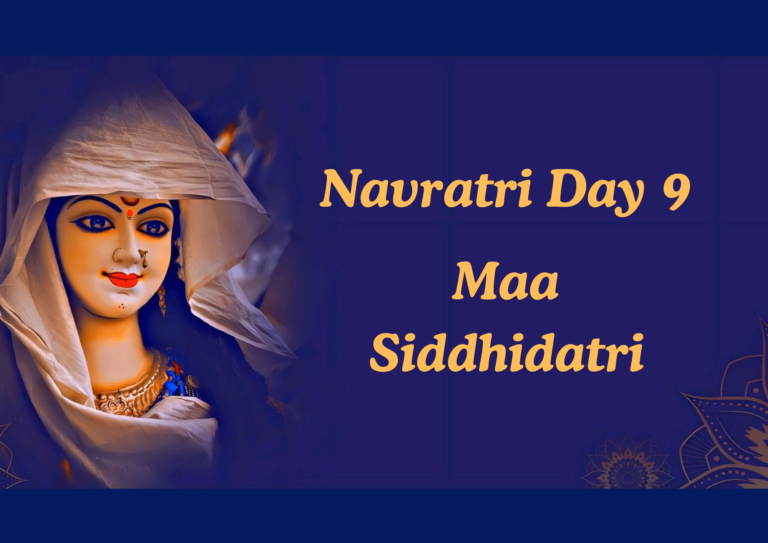Navratri, the vibrant and spiritually uplifting festival, culminates on its ninth day with the worship of Maa Siddhidatri, the goddess who bestows ultimate perfection (Siddhi) and divine blessings upon her devotees. This day, known as “Maha Navami,” holds profound significance as it completes the journey of spiritual awakening and devotion that Navratri represents.
Significance of Worshiping Maa Siddhidatri
Maa Siddhidatri is revered as the embodiment of divine knowledge and wisdom. According to Hindu mythology, she is the manifestation of the supreme power who grants eight forms of Siddhis (supernatural powers) to her devotees. These Siddhis are Anima (the ability to become small), Mahima (the ability to grow infinitely), Garima (the power to become heavy), Laghima (the power to become light), Prapti (the ability to obtain anything), Prakamya (the ability to fulfill desires), Ishitva (lordship over creation), and Vashitva (control over nature).
In this form, Maa Siddhidatri is often depicted seated on a lotus, radiating calm and composure. She is adorned with four arms, holding a discus (Sudarshan Chakra), a lotus, a mace, and a conch, symbolizing her power to sustain, protect, and bless the universe.
Her worship on the ninth day of Navratri signifies the attainment of spiritual enlightenment. Devotees believe that by worshiping Maa Siddhidatri, they can remove ignorance, gain spiritual wisdom, and experience the ultimate union with the divine. She blesses her followers with both material and spiritual wealth, helping them achieve their goals in life.
Symbolism of Maa Siddhidatri
The symbolism of Maa Siddhidatri is deeply connected to the balance of power and knowledge. She represents the culmination of the spiritual journey, where the seeker attains complete knowledge of the universe and the self. Her seated posture on a lotus symbolizes purity, detachment, and the unfolding of spiritual consciousness. The four hands holding sacred items depict her role as the nurturer of life, the protector of righteousness, and the provider of divine blessings.
Maa Siddhidatri is also considered the giver of “moksha” (liberation) from the cycle of birth and death, making her worship an essential part of the spiritual evolution of a devotee. Her association with Lord Shiva is significant—she is believed to have granted him the powers to form his “Ardhanarishvara” form, a half-male, half-female deity symbolizing the balance of masculine and feminine energies in the cosmos.
Rituals of Worship on Navratri Day 9
The ninth day of Navratri, Maha Navami, is marked by grand celebrations, rituals, and fervent devotion. The rituals performed on this day are dedicated to invoking the blessings of Maa Siddhidatri and concluding the Navratri period on a high spiritual note.
- Kalash Sthapana and Navami Puja: The day begins with the worship of the Kalash, a sacred vessel that symbolizes the presence of the divine. Devotees perform special pujas, offering flowers, fruits, incense, and sweets to Maa Siddhidatri. The recitation of Siddhidatri Stotra or Durga Saptashati is common during this time.
- Kanya Puja: One of the most important rituals on Maha Navami is the Kanya Puja, where nine young girls (representing the nine forms of Durga) are invited to homes and temples. These girls are revered as embodiments of the goddess herself. Devotees wash their feet, offer them food, gifts, and new clothes, seeking their blessings for prosperity and happiness.
- Chanting and Meditation: Devotees spend the day chanting mantras and hymns dedicated to Maa Siddhidatri. Meditation and silent prayers are observed to seek spiritual fulfillment and inner peace. The mantra “Om Siddhidatri Namah” is chanted with devotion to invoke the goddess’s grace and blessings.
- Homam (Sacred Fire Ritual): Many temples and households organize a Homam, a sacred fire ceremony where offerings are made to the divine to seek protection and blessings. The fire represents the energy of Maa Siddhidatri, and the offerings symbolize the devotee’s surrender to the divine will.
- Navami Bhog: Devotees prepare special meals and offer them to Maa Siddhidatri. The bhog (offering) usually includes halwa, puri, and chana, which are later distributed among devotees and the needy.
- Dance and Cultural Performances: In various parts of India, particularly in Gujarat and West Bengal, the day is celebrated with joyous dance forms like Garba and Dandiya, along with cultural performances showcasing the victory of good over evil.
The Spiritual Essence of Navratri Day 9
Navratri Day 9 symbolizes the realization of divinity within oneself. It is the day when the devotee experiences the culmination of their efforts over the past eight days of worship and penance. The connection with Maa Siddhidatri signifies the final step toward attaining divine wisdom and blessings. The energy of this day is believed to clear obstacles, illuminate the mind, and provide clarity of thought.
As Maa Siddhidatri bestows the ultimate knowledge of the cosmos and the power of liberation, devotees experience a deep sense of fulfillment and joy. The rituals performed on this day are not just about materialistic achievements but about transcending the limitations of the physical world and realizing one’s true potential in the divine realm.
In essence, the ninth day of Navratri is the spiritual peak of the festival, a day when the devotee’s faith, perseverance, and devotion are rewarded by the grace of Maa Siddhidatri. Her blessings help devotees move forward in life with knowledge, peace, and contentment, ready to embrace both worldly and spiritual success.
Conclusion: As Navratri 2024 comes to an end, the worship of Maa Siddhidatri brings the festival full circle, completing the cycle of devotion and spiritual awakening. The goddess’s divine grace guides her devotees toward the ultimate realization of their spiritual goals, helping them attain Siddhi (perfection) and prosperity in all aspects of life.


